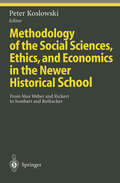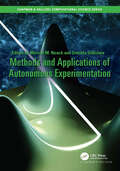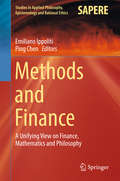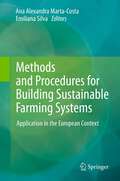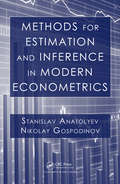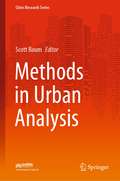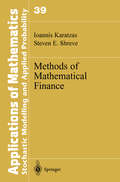- Table View
- List View
Methodology of the Social Sciences, Ethics, and Economics in the Newer Historical School: From Max Weber and Rickert to Sombart and Rothacker (Ethical Economy)
by A. M. HaukThe volume at hand gives an exposition of the tradition of the Historical School of Economics and of the Geisteswissenschaften or human sciences, the latter in their development within the Historical School as well as in Neo-Kantianism and the sociology of knowledge. It continues the discussion started in the year 1994 on the Older Historical School of Economics and the 19th century German contribution to an ethical theory of economics with the Newer Historical School of the 20th century. Economists, social scientists, and philosophers examine the contribution of this tradition and its impact for present theory. The schools of thought and their approaches to economics as well as to the cultural and social sciences are examined here not as much for their historical interest as for their poten tial systematic contribution to the contemporary debates on economic ethics, economics, sociology, and philosophy. The volume at hand contains the proceedings of the Fourth Annual SEEP-Conference on Economic Ethics and Philosophy in 1996, "Economics and Ethics in the Historical School. Part B: Max Weber, Heinrich Rickert, Max Scheler, Werner Sombart, Arthur Spiethoff, John Commons, Alfred Marshall, and Others", held at Marienrode Monastery near Hannover, Germa ny, on March 27-30th, 1996, together with several additional invited papers.
Methodology of Uniform Contract Law: The UNIDROIT Principles in International Legal Doctrine and Practice
by Maren HeidemannThis book examines uniform contract law in all relevant areas of legal doctrine and practice, and considers the barriers which exist toward it in modern nation states, namely in the German and English legal systems. The author suggests ways to overcome these obstacles, and develops an autonomous methodology of interpretation of transnational contract principles. The book analyses existing uniform transnational law rules, such as the UNIDROIT Principles of International Commercial Contracts.
Methodology, Theory, and Knowledge in the Managerial and Organizational Sciences: Actions and Consequences (Non-ser.)
by Eliezer GeislerGeisler argues that the over-reliance on co-variation techniques and statistical methods, instead of process approach and in-depth analysis, produces meaningless knowledge in the managerial and organizational sciences, and indeed throughout all the social sciences. He offers instead a new and different approach, based on the notion of what he calls dynamic morphologies—an architecture of slicing complex phenomena. This way it is possible to explain many inconsistencies in research findings, and to find a cohesive, systematic outlook on research, research design, and knowledge creation. Intellectually challenging and following in the footsteps of Kuhn, Argyris, and Popper, Geisler's approach is frankly revolutionary in research design and contains its own notions, terms, and nomenclature. A provocative discussion for academics and others well trained in the organizational, managerial, and social sciences.Geisler's dynamic morphologies provide a means to research complex phenomena and gain knowledge about them. They are composed of a chain of events, combined logically and temporally, and a method by which this process is studied. Geisler also contends that knowledge in the organizational and managerial sciences is only viable when it describes and explains the complex, higher-order phenomena. Therefore, theory building and research in these fields must be linked to higher-order constructs and the phenomena that they attempt to explain. This is the central notion of amplitude that Geisler introduces and describes. His book also criticizes the evolutionary epistemology view of knowledge creation and contends that knowledge in all of these fields of study in general is not evolutionary, but instead, cumulative and expansive.
Methods and Applications of Autonomous Experimentation (Chapman & Hall/CRC Computational Science)
by Marcus M. Noack Daniela UshizimaAutonomous Experimentation is poised to revolutionize scientific experiments at advanced experimental facilities. Whereas previously, human experimenters were burdened with the laborious task of overseeing each measurement, recent advances in mathematics, machine learning and algorithms have alleviated this burden by enabling automated and intelligent decision-making, minimizing the need for human interference. Illustrating theoretical foundations and incorporating practitioners’ first-hand experiences, this book is a practical guide to successful Autonomous Experimentation. Despite the field’s growing potential, there exists numerous myths and misconceptions surrounding Autonomous Experimentation. Combining insights from theorists, machine-learning engineers and applied scientists, this book aims to lay the foundation for future research and widespread adoption within the scientific community. This book is particularly useful for members of the scientific community looking to improve their research methods but also contains additional insights for students and industry professionals interested in the future of the field.
Methods and Applications of Autonomous Experimentation (Chapman & Hall/CRC Computational Science)
Autonomous Experimentation is poised to revolutionize scientific experiments at advanced experimental facilities. Whereas previously, human experimenters were burdened with the laborious task of overseeing each measurement, recent advances in mathematics, machine learning and algorithms have alleviated this burden by enabling automated and intelligent decision-making, minimizing the need for human interference. Illustrating theoretical foundations and incorporating practitioners’ first-hand experiences, this book is a practical guide to successful Autonomous Experimentation. Despite the field’s growing potential, there exists numerous myths and misconceptions surrounding Autonomous Experimentation. Combining insights from theorists, machine-learning engineers and applied scientists, this book aims to lay the foundation for future research and widespread adoption within the scientific community. This book is particularly useful for members of the scientific community looking to improve their research methods but also contains additional insights for students and industry professionals interested in the future of the field.
Methods and Finance: A Unifying View on Finance, Mathematics and Philosophy (Studies in Applied Philosophy, Epistemology and Rational Ethics #34)
by Emiliano Ippoliti Ping ChenThe book offers an interdisciplinary perspective on finance, with a special focus on stock markets. It presents new methodologies for analyzing stock markets’ behavior and discusses theories and methods of finance from different angles, such as the mathematical, physical and philosophical ones. The book, which aims at philosophers and economists alike, represents a rare yet important attempt to unify the externalist with the internalist conceptions of finance.
Methods and Models in Transport and Telecommunications: Cross Atlantic Perspectives (Advances in Spatial Science)
by Aura Reggiani Laurie A. SchintlerOne aspect of the new economy is a transition to a networked society, and the emergence of a highly interconnected, interdependent and complex system of networks to move people, goods and information. An example of this is the in creasing reliance of networked systems (e. g. , air transportation networks, electric power grid, maritime transport, etc. ) on telecommunications and information in frastructure. Many of the networks that evolved today have an added complexity in that they have both a spatial structure – i. e. , they are located in physical space but also an a spatial dimension brought on largely by their dependence on infor mation technology. They are also often just one component of a larger system of geographically integrated and overlapping networks operating at different spatial levels. An understanding of these complexities is imperative for the design of plans and policies that can be used to optimize the efficiency, performance and safety of transportation, telecommunications and other networked systems. In one sense, technological advances along with economic forces that encourage the clustering of activities in space to reduce transaction costs have led to more efficient network structures. At the same time the very properties that make these networks more ef ficient have also put them at a greater risk for becoming disconnected or signifi cantly disruptedwh en super connected nodes are removed either intentionally or through a targeted attack.
Methods and Procedures for Building Sustainable Farming Systems: Application in the European Context
by Ana Alexandra Marta-Costa and Emiliana SilvaShowing how the method of sustainability assessment plays a key role in choosing the best agricultural productive mode, this book guides the reader through the process of selecting, from among the various approaches for building farming systems, the method of decision-making that will result in the most appropriate outcome, given the context. Case studies hail from polities as diverse as Portugal and Canada, Argentina and Lebanon. The work thus offers a valuable critical survey of the assessment methods that account for sustainability and economics, and which have developed considerably in the last two decades. The heterogeneous approaches covered here make this volume appropriate for consultation in a wide variety of social, political and geographical contexts.
Methods and Tools for Effective Knowledge Life-Cycle-Management
by Alain Bernard Serge TichkiewitchKnowledge Management is a wide, critical and strategic issue for all the com- nies, from the SMEs to the most complex organizations. The key of competiti- ness is knowledge, because of the necessity of reactivity, flexibility, agility and innovation capacities. Knowledge is difficult to measure itself but what is visible, this is the way of improving products, technologies and enterprise organizations. During the last four years, based on the experience of most of the best experts around the World, CIRP (The International Academy for Production Engineering) has decided to prepare and structure a Network of Excellence (NoE) proposal. The European Community accepted to found the VRL-KCiP (Virtual Research La- ratory – Knowledge Community in Production). As its name indicates it, the aim of this NoE was really to build a «Knowledge Community in Production ». This was possible and realistic because the partners were representative of the most important universities in Europe and also because of strong partnerships with laboratories far from Europe (Japan, Australia, South Africa, USA, etc…). Based on such powerful partnership, the main issue was to help European manufacturing industry to define and structure the strategic knowledge in order to face the strategic worldwide challenges. Manufacturing in Europe currently has two essential aspects: 1. It has to be knowledge intensive given the European demands for high-tech products and services (e.g. electronics, medicines).
Methods for Applied Macroeconomic Research
by Fabio CanovaThe last twenty years have witnessed tremendous advances in the mathematical, statistical, and computational tools available to applied macroeconomists. This rapidly evolving field has redefined how researchers test models and validate theories. Yet until now there has been no textbook that unites the latest methods and bridges the divide between theoretical and applied work. Fabio Canova brings together dynamic equilibrium theory, data analysis, and advanced econometric and computational methods to provide the first comprehensive set of techniques for use by academic economists as well as professional macroeconomists in banking and finance, industry, and government. This graduate-level textbook is for readers knowledgeable in modern macroeconomic theory, econometrics, and computational programming using RATS, MATLAB, or Gauss. Inevitably a modern treatment of such a complex topic requires a quantitative perspective, a solid dynamic theory background, and the development of empirical and numerical methods--which is where Canova's book differs from typical graduate textbooks in macroeconomics and econometrics. Rather than list a series of estimators and their properties, Canova starts from a class of DSGE models, finds an approximate linear representation for the decision rules, and describes methods needed to estimate their parameters, examining their fit to the data. The book is complete with numerous examples and exercises. Today's economic analysts need a strong foundation in both theory and application. Methods for Applied Macroeconomic Research offers the essential tools for the next generation of macroeconomists.
Methods for Applied Macroeconomic Research
by Fabio CanovaThe last twenty years have witnessed tremendous advances in the mathematical, statistical, and computational tools available to applied macroeconomists. This rapidly evolving field has redefined how researchers test models and validate theories. Yet until now there has been no textbook that unites the latest methods and bridges the divide between theoretical and applied work. Fabio Canova brings together dynamic equilibrium theory, data analysis, and advanced econometric and computational methods to provide the first comprehensive set of techniques for use by academic economists as well as professional macroeconomists in banking and finance, industry, and government. This graduate-level textbook is for readers knowledgeable in modern macroeconomic theory, econometrics, and computational programming using RATS, MATLAB, or Gauss. Inevitably a modern treatment of such a complex topic requires a quantitative perspective, a solid dynamic theory background, and the development of empirical and numerical methods--which is where Canova's book differs from typical graduate textbooks in macroeconomics and econometrics. Rather than list a series of estimators and their properties, Canova starts from a class of DSGE models, finds an approximate linear representation for the decision rules, and describes methods needed to estimate their parameters, examining their fit to the data. The book is complete with numerous examples and exercises. Today's economic analysts need a strong foundation in both theory and application. Methods for Applied Macroeconomic Research offers the essential tools for the next generation of macroeconomists.
Methods for Estimation and Inference in Modern Econometrics
by Stanislav Anatolyev Nikolay GospodinovMethods for Estimation and Inference in Modern Econometrics provides a comprehensive introduction to a wide range of emerging topics, such as generalized empirical likelihood estimation and alternative asymptotics under drifting parameterizations, which have not been discussed in detail outside of highly technical research papers. The book also add
Methods for Researching Professional Learning and Development: Challenges, Applications and Empirical Illustrations (Professional and Practice-based Learning #33)
by Michael Goller Eva Kyndt Susanna Paloniemi Crina DamşaThis volume provides alternatives for tackling existing empirical, methodological, and analytical challenges. It does so by providing a broad overview of less established, as well as emerging methods, which are of great relevance for current research on professional learning and development. As such, it offers a comprehensive collection of state-of-the-art methodologies and future directions within the workplace learning and professional development research. By describing these novel approaches and providing empirical illustrations, the book promotes innovative methodologies for investigating professional learning and development. It also supports scholars to understand upcoming empirical research and methods and encourages novice as well as established researchers to adopt new empirical strategies beyond traditional ones that have the potential to enrich a better understanding of professional learning and development.
Methods in Experimental Economics: An Introduction (Springer Texts in Business and Economics)
by Joachim Weimann Jeannette Brosig-KochThis textbook provides a hands-on and intuitive overview of the methodological foundations of experimental economics. Experimental economic research has been an integral part of economic science for quite some time and is gaining more and more attention in related disciplines. The book addresses the design and execution of experiments, the evaluation of experimental data and the equipment of an experimental laboratory. It illustrates the challenges involved in designing and conducting experiments and helps the reader to address them in practice.
Methods in Premodern Economic History: Case studies from the Holy Roman Empire, c.1300-c.1600 (Palgrave Studies in Economic History)
by Ulla Kypta Julia Bruch Tanja SkambraksThis edited collection demonstrates how economic history can be analysed using both quantitative and qualitative methods, connecting statistical research with the social, cultural and psychological aspects of history. With their focus on the time between the end of the commercial revolution and the Black Death (c. 1300), and the Thirty Years’ War (c. 1600), Kypta et al. redress a significant lack of published work regarding economic history methodology in the premodern period.Case studies stem from the Holy Roman Empire, one of the most important economic regions in premodern times, and reconnect the German premodern economic history approach with the grand narratives that have been developed mainly for Western European regions. Methodological approaches stemming from economics as well as from sociology and cultural studies show how multifaceted research in economic history can be, and how it might accordingly offer us new insights into premodern economies.Chapters 9 and 10 are available open access under a Creative Commons Attribution 4.0 International License via link.springer.com.
Methods in Product Design: New Strategies in Reengineering
by Ali K. Kamrani Maryam AzimiAs industries adopt consumer-focused product development strategies, they should offer broader product ranges in shorter design times and the processes that can manufacture in arbitrary lot sizes. In addition, they would need to apply state-of-the-art methods and tools to easily conduct early product design and development trade-off analysis among competing objectives. Methods in Product Design: New Strategies in Reengineering supplies insights into the methods and techniques that enable implementing a consumer-focused product design philosophy by integrating design and development capabilities with intelligent computer-based systems. The book defines customer focused design and discusses ways to assess changing demands and sources, and delves into what is needed to successfully manufacture goods in a demanding market. It reviews proven methods for assessing customer need. Then, after showing how changing needs impact the reengineering of products, it explains how change can be efficiently achieved. It details how IT advances and technology support customer-focused product development, discusses cutting-edge mass customization principles that maximize cost-effective production, and illustrates how to implement effective predictive maintenance policies.Methods in Product Design: New Strategies in Reengineering provides methods, state-of-the-art technologies, and new strategies for customer-focused product design and development that allow organizations to quickly respond to the demanding global marketplace.
Methods in Product Design: New Strategies in Reengineering
by Ali K. Kamrani Maryam Azimi Abdulrahman M. Al-AhmariAs industries adopt consumer-focused product development strategies, they should offer broader product ranges in shorter design times and the processes that can manufacture in arbitrary lot sizes. In addition, they would need to apply state-of-the-art methods and tools to easily conduct early product design and development trade-off analysis among competing objectives. Methods in Product Design: New Strategies in Reengineering supplies insights into the methods and techniques that enable implementing a consumer-focused product design philosophy by integrating design and development capabilities with intelligent computer-based systems. The book defines customer focused design and discusses ways to assess changing demands and sources, and delves into what is needed to successfully manufacture goods in a demanding market. It reviews proven methods for assessing customer need. Then, after showing how changing needs impact the reengineering of products, it explains how change can be efficiently achieved. It details how IT advances and technology support customer-focused product development, discusses cutting-edge mass customization principles that maximize cost-effective production, and illustrates how to implement effective predictive maintenance policies.Methods in Product Design: New Strategies in Reengineering provides methods, state-of-the-art technologies, and new strategies for customer-focused product design and development that allow organizations to quickly respond to the demanding global marketplace.
Methods in Urban Analysis (Cities Research Series)
by Scott BaumThis book highlights major quantitative and qualitative methods and approaches used in the field of urban analysis. The respective chapters cover the background and relevance of various approaches to urban studies and offer guidance on implementing specific methodologies. Each chapter also provides links to real-world examples. The book is unique in its focus on Australian examples and subject matter, presented by recognized experts in the field.
Methods of Economic Research: Craftsmanship and Credibility in Applied Microeconomics (Springer Texts in Business and Economics)
by Darren GrantThis textbook articulates the elements of good craftsmanship in applied microeconomic research and demonstrates its effectiveness with multiple examples from economic literature. Empirical economic research is a combination of several elements: theory, econometric modelling, institutional analysis, data handling, estimation, inference, and interpretation. A large body of work demonstrates how to do many of these things correctly, but to date, there is no central resource available which articulates the essential principles involved and ties them together. In showing how these research elements can be best blended to maximize the credibility and impact of the findings that result, this book presents a basic framework for thinking about craftsmanship. This framework lays out the proper context within which the researcher should view the analysis, involving institutional factors, complementary policy instruments, and competing hypotheses that can influence or explain the phenomena being studied. It also emphasizes the interconnectedness of theory, econometric modeling, data, estimation, inference, and interpretation, arguing that good craftsmanship requires strong links between each. Once the framework has been set, the book devotes a chapter to each element of the analysis, providing robust instruction for each case. Assuming a working knowledge of econometrics, this text is aimed at graduate students and early-career academic researchers as well as empirical economists looking to improve their technique.
Methods of Housing Analysis: Techniques and Case Studies
by A. James GregorIn order to understand and formulate housing policy and programs, it is necessary to have a working knowledge of the internal economic operation of housing from the points of view of both the investor and the owner. James W. Hughes argues that investors' and owners' behavior and activity tend to be governed by market forces and other realities. In that regard, he begins this work by analyzing market rates of return in real estate and housing undertakings, and the variety of analytical techniques which underlie their determination.Methods of Housing Analysis is designed to provide urban planners with an introduction to the basic, quantitative techniques associated with the analysis of housing. A myriad of specific analytical methods has evolved in each of the professions concerned with this subject area. Planners, investors, developers, engineers, appraisers, social scientists, and governmental officials all tend to exhibit unique perspectives when examining housing and have developed their analytical frameworks accordingly.The work is comprised of an extensive discussion by the author, detailed case studies and examples, and a number of essays by leading experts that detail specific analytical procedures and demonstrate their use. The book is divided into four major sections: analysis of the internal operation of housing; basic cost-revenue analysis; expanded cost-revenue/benefit analysis; and government regulation of housing. The thorough nature of Hughes' discussion and of the related readings makes this volume an ideal textbook and reference source.
Methods of Housing Analysis: Techniques and Case Studies
by A. James GregorIn order to understand and formulate housing policy and programs, it is necessary to have a working knowledge of the internal economic operation of housing from the points of view of both the investor and the owner. James W. Hughes argues that investors' and owners' behavior and activity tend to be governed by market forces and other realities. In that regard, he begins this work by analyzing market rates of return in real estate and housing undertakings, and the variety of analytical techniques which underlie their determination.Methods of Housing Analysis is designed to provide urban planners with an introduction to the basic, quantitative techniques associated with the analysis of housing. A myriad of specific analytical methods has evolved in each of the professions concerned with this subject area. Planners, investors, developers, engineers, appraisers, social scientists, and governmental officials all tend to exhibit unique perspectives when examining housing and have developed their analytical frameworks accordingly.The work is comprised of an extensive discussion by the author, detailed case studies and examples, and a number of essays by leading experts that detail specific analytical procedures and demonstrate their use. The book is divided into four major sections: analysis of the internal operation of housing; basic cost-revenue analysis; expanded cost-revenue/benefit analysis; and government regulation of housing. The thorough nature of Hughes' discussion and of the related readings makes this volume an ideal textbook and reference source.
Methods of Long-Term Planning and Forecasting: Conference Proceedings (International Economic Association Series #Vol. 38)
by T. S. KhachaturovMethods of Mathematical Finance (Probability Theory and Stochastic Modelling #39)
by Ioannis Karatzas Steven ShreveThis sequel to Brownian Motion and Stochastic Calculus by the same authors develops contingent claim pricing and optimal consumption/investment in both complete and incomplete markets, within the context of Brownian-motion-driven asset prices. The latter topic is extended to a study of equilibrium, providing conditions for existence and uniqueness of market prices which support trading by several heterogeneous agents. Although much of the incomplete-market material is available in research papers, these topics are treated for the first time in a unified manner. The book contains an extensive set of references and notes describing the field, including topics not treated in the book. This book will be of interest to researchers wishing to see advanced mathematics applied to finance. The material on optimal consumption and investment, leading to equilibrium, is addressed to the theoretical finance community. The chapters on contingent claim valuation present techniques of practical importance, especially for pricing exotic options.
Methods of Mathematical Finance (Stochastic Modelling And Applied Probability Ser. #39)
by Ioannis Karatzas Steven ShreveThis sequel to Brownian Motion and Stochastic Calculus by the same authors develops contingent claim pricing and optimal consumption/investment in both complete and incomplete markets, within the context of Brownian-motion-driven asset prices. The latter topic is extended to a study of equilibrium, providing conditions for existence and uniqueness of market prices which support trading by several heterogeneous agents. Although much of the incomplete-market material is available in research papers, these topics are treated for the first time in a unified manner. The book contains an extensive set of references and notes describing the field, including topics not treated in the book. This book will be of interest to researchers wishing to see advanced mathematics applied to finance. The material on optimal consumption and investment, leading to equilibrium, is addressed to the theoretical finance community. The chapters on contingent claim valuation present techniques of practical importance, especially for pricing exotic options.
Methods of Moments and Semiparametric Econometrics for Limited Dependent Variable Models
by Myoung-jae LeeIn this book the author surveys new techniques in econometrics which may be used to analyse semiparametric models. As well as covering topics such as instrumental variable estimation, nonparametric density and regression function estimation and semiparametric limited dependent variable models, the book provides details of how these methods may be implemented using software.
